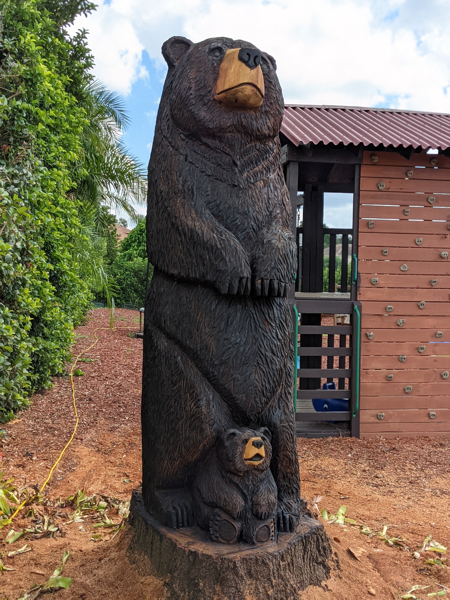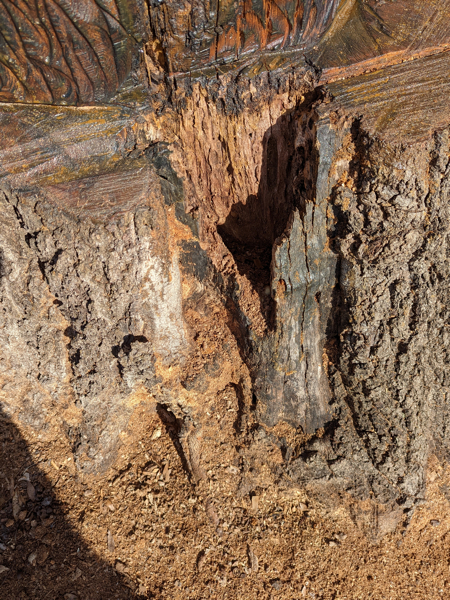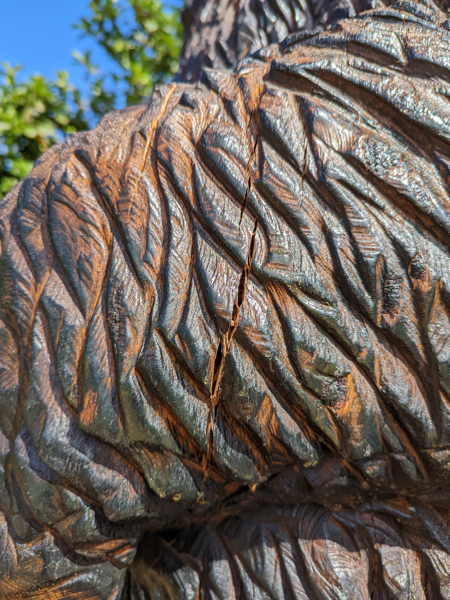Home > Q&A Main Page > Miscellaneous Q&A Index > Bear Sculpture Project
Rot Doctor
Subject: Bear Sculpture Project
Date: Tuesday, November 9, 2021
Hi there, we recently had a large oak go down on our property and used the opportunity to keep about 10 feet of the tree and have a chainsaw artist carve a bear and cub into it.
As he carved, he did find some bad areas around one of the legs and then a couple of bad spots in the stump base. I am attaching pictures. I’ve also noticed that there are some cracks developing in the Bear recently (although nothing too significant) maybe because of some cold weather that just came in during the past week.
I am going to send pictures in a couple of separate emails for any guidance you can provide on:
- 1) how to treat the more significant hole in the stump
- 2) how to treat the soft rotting spot in the leg
- 3) how to handle the new cracks developing (if anything).
We did treat the Bear with a couple coats of Cabot Australian Timber Oil sold by Lowes (recommended by sculptor).
I saw your article on repairing and treating a large bear sculpture. I’m guessing I can keep my Bear on the original stump for now and consider the more extreme move of cutting it off and putting it on a concrete foundation later? I was hoping I could stay on top of treating and maintaining it all to keep it in good condition longer.
Thanks for any help you can provide.
Paul D.




Paul,
First, I love the carving! It is too cute.
As far as the rot pocket, make sure the wood is dry. If it is deeper than 1 inch, drill some holes across the top of the rotted area, and use these holes to introduce S-1 Sealer to the middle of the rot, as well as painting it on the surface. Keep filling the drill holes as long as it is absorbing at the same rate as at the beginning. Apply every 10-30 seconds, repeatedly. Normally we tell people to apply until the wood stops absorbing. But with end grain, that doesn’t actually happen. But it should slow down significantly, at which point you can let things cure for 1 week. Fill in the drill holes with General Purpose Epoxy Resin, and fill in any missing wood as desired, with Sculpwood Epoxy Paste, either as is, or thickened with our fine sawdust. You can tint this mixture with our brown resin dye to get it close to the color of the rest of the wood, if necessary.
For the cracks, I would squirt S-1 Sealer inside, using our #107 injection kit. You could fill them, but unless water is likely to puddle in them, I would be inclined to leave them. Radial cracks develop in wood. In our bear, it was on large crack, in the back, fortunately. Cracks form from the initial drying process, or from subsequent moisture moving in and out of the wood. The S-1 applied to anywhere that moisture easily gets into the wood will help to significantly reduce this. In your structure, this is primarily end grain. So, the top of the mother bear would be the most vulnerable. But the mother’s feet, and cub’s head would be other places.
That just leaves the biggest issue. The base. As you know, carpenter ants caused significant damage to the bear we repaired. Ants, termites, or a myriad of other insects could do the same to your structure. Leaving it on the stump leaves it vulnerable to this, or wood rot, if there is significant ground moisture annually at your location.
Of course, damaged or not, taking such a large carving off the stump is a big job. If you didn’t want to do this, I might suggest drilling many holes into the base, and putting a lot of Impel Rods into the holes. In almost every case, I am not a fan of using Impel Rods. Your situation might be the exception. I don’t know if it would prevent insect damage or rot decay. But it would certainly help to resist it as much as is practical, short of removal.
If you decided to do this, keep in mind that Impel Rods would not prevent damage further down into the stump. But it could well preserve the above ground portion to the point that you could more readily move the carving to a pedestal in the future.
Hopefully you find the above helpful. Please let me know if you have further questions.
Doc
Have questions?
Contact us by phone 206-364-2155 or e-mail (send us your pictures) at drrot@rotdoctor.com and we will gladly answer questions about our products or how to apply them. With 20+ years of experience and many more in the boating and construction industries, not much surprises us. We are here to help our customers solve their issues. Let us help you to not have any surprises in your repair project.
